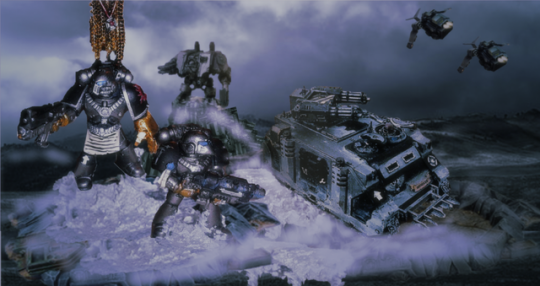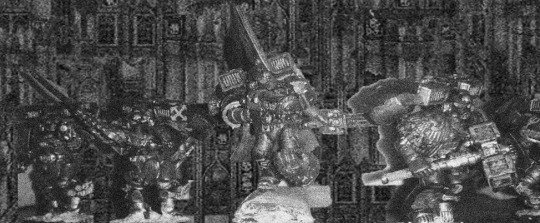#Taro Exitas
Text
Entry #005.2ndcompany.v2[avaronedit].txt

--The Second Company, Part 1 of 5--
+Header Item: Pict-Capture, elements of the Second Company, Iron Fists Chapter, during deployments on Crucible, Poros Crusade, 985.M41. The Departmento Photartem formally apologises for resolution losses and degradation encountered during processing.+
Within every Astartes chapter, there is a company that occupies the lion's share of the spotlight. For some, this is the result of years of dutiful service, such as the Dark Angels' fifth company, or a hereditary, prominent position at the tip of the spear in the case of the Space Wolves' Blackmanes. The Ultramarines second company, oft-referred to as the Guardians of the Temple, exemplify this trend most clearly, thanks to their 'crafted...reputation as dynamic heroes'. The test for such prominence is fairly trivial, and requires that one merely browse the galleries of chapter artwork and identify the company heraldry that comes up most frequently.
For the Iron Fists, this trend manifests strongest around the Second company, sometimes colloquially known as the black-blades, but more often referred to as simply "The Second". However, unlike the famous companies of first-founding chapters, the Second's prominence in the eyes of the outside world is not the result of a prodigiously long roll of honour, nor a saga of dramatic, galaxy-shaking deeds. It is a quirk of doctrine that makes the Iron Fists' Second stand out.
The bespoke organisational layout of the Second dates back to around 350.M39, some half-century hence of the Fall of Taralus during Abaddon's tenth black crusade. With limited resources with which to rebuild the shattered chapter, surviving command staff were compelled to devise novel force structures in order to maximise the utility of what few assets they had. Swiftly-promoted from savant-initiate to captain (a normally unprecedented ascension that owed more to the lack of more senior candidates with more seniority), it was Llewellus Thoca who received the responsibility of reforging the Second.
Thoca deserves a treatise all of his own (which I am told exists but am struggling to locate at present), but his restructuring of the Second was one of the earliest and most immediately effective measures of its kind. The company focused itself around a core of assault veterans who had survived the Fall of Taralus by near-constant ship defence actions. The successful utilisation of these squads would prove pivotal in the company's first actions since the fall, and gradually the company's doctrine would shift towards creating and exploiting scenarios where their effect could be maximised, usually in the form of rapid, pinpoint strikes on key enemy targets.
This structure had its fair share of downsides. The Second had significantly less specialised resources at its disposal in comparison to its contemporaries. The company's core strength was bound up in close-range infantry, and if improperly commanded, that infantry would take heavy casualties, especially if tasked to handle threats they were incapable or inequipped to face. These core assault squads also required significant coordination inside and outside the Second, which required company command to establish and maintain high levels of trust and cooperation with outsiders.
Nevertheless, such hardships would foster unique levels of proficiency across the company's tactical, assault and devastator units, creating a company-wide focus on cohesion, diplomacy and quality intelligence gathering. The entombment of select veterans of the company into dreadnought chassis would further this trend by preserving hard-won expertise for future generations to learn from. In particular, the tactical squads of the second company would develop a bespoke reputation for quality, both within and beyond the chapter, and it was not uncommon for individual squads to be placed under the command of other captains in instances where well-disciplined line troops were vital.
Thus, when the Second was suitably managed and supported, their ability to turn the tide of battles or even whole campaigns was profound. Such deployments frequently put elements of the Second in positions of much greater visibility to mortal soldiery and imperial commanders alike, in stark comparison to the other four battle companies who were generally more capable of operating alone. This factor would be further enhanced by the personality of the Second's captains, who were chosen by vote from within the company and were generally selected for their zeal, inspirational abilities and diplomatic candor, all the better to secure the collaboration that made the Second effective.
+Supplementary Log, Cosrau Yandin, Captain, 7th Company Iron Fists+
As a former sergeant of the Second's sixth tactical squad, Captain Yandin had this to say when asked about the prominence of the company. [edited for brevity]
"This is a feature, not a glitch. The Second lives and dies on its reputation. The moment it is perceived as unreliable by those it fights alongside, it is no longer able to draw on the support, intelligence or specialist units that allow it to fight as well as it does. You've only to look to instances like Ibossim to see how the Second fares when fighting alone."
"A lot of the training leverages this mechanic. While you always train with your squad, eight times out of ten your squad trains alone. This cultivates an understanding of what happens when you are unsupported. If you make a mistake, you die, and so do those around you. The pressure is extremely fierce, as a result."
"This pressure extends to every part of the company . A warrior of the Second bears responsibility for the lives of those they fight beside. But a captain of the Second carries the entire company on their shoulders. It lives and dies with him. He must be considerate enough to soothe his allies, yet passionate enough to inspire them. He must carefully consider his stratagems, yet always be ready to join the fray himself. He must be open minded to new ideas, but throne forbid he make a mistake."
"That's not to say it's all as brutal as it sounds. Yes, I mean it, stop looking at me like that. The Second has just as long a history of teaching its members as it does combat-simming them into perfectionists. Sharing knowledge strengthens the whole company. Ascendants teach the sergeants, who teach each other, who teach the rank and file. [Author's note: 'Ascendant' is a term used within the company to refer to those interred in dreadnoughts.] The first squad was a self-contained bladesmanship academy long before it was the captain's personal bodyguard, and those who do make captain often spend decades being prepared for the role by their predecessor. The last captain, Exitas, could trace the teachings he received all the way back into M40, when Hayabusa Shandar was wrestling necrons out of their night scythes."
"That tradition could've continued for another thousand years, had his tenure not ended so abruptly. Exitas died on Kalidos, during the retreat from the Stygius sector, barely thirty years into his tenure and with no suitable successor prepared. Throne, it wouldn't have been so bad if we'd just lost Exitas. Samas Tenebra was right there, Exitas' direct predecessor, the only First Captain in the chapter's history to have risen from the Second. There was literally no better to teach Exitas' successor, but then Saphyre happened, and before either of them were laid to rest in Taralan soil, our beloved Chapter Master bike-slides onto the Tsiolkovan and declares Throne-damned cog-brained Artos Myra as Second Captain and before you know it-"
+Log terminated: storage capacity exceeded+
Saved by the voxcaptor,
Hester Vinchix Calimorre, Historiographer-Moderatus, Logos Historica Verita.
+Attached Image: Second Captain Shado Avaron in action at the head of first squad Zaio, second company, during the "Ibossim Bloodbath", circa 639.M41. Recovered from data-fragments extracted from Praetorian XIX regimental datalink.+

#40k#warhammer 40k#warhammer 40000#space marines#iron fists#Cosrau Yandin#Second Company Iron Fists#Shado Avaron#Taro Exitas#The Ibossim Bloodbath#The Stygius Crusade#H. V. Calimorre
3 notes
·
View notes